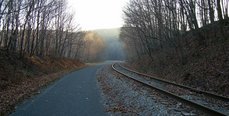Dulles needs an express rail line
This is one-half of a point-counterpoint about transit in the Dulles corridor. Read the opposing viewpoint.
The Metro’s new Silver Line is officially called the “Dulles corridor extension,” and as currently planned is acting as a commuter rail line connecting the upper Fairfax and Loudoun exurbs with Downtown DC. It’ll also create the only rail link to Dulles Airport. While connecting the IT heart of Northern Virginia to the greater DC rail system is strongly needed, so is providing an efficient and speedy means of public transportation to the region’s largest airport. The Silver Line doesn’t provide that. The region should consider a faster link to Dulles Airport along the W&OD trail.
On the currently-planned line, Dulles Airport will be 8 stops from the Orange Line at East Falls Church, 18 stops from Metro Center, and 21 stops including a transfer from Union Station. By comparison, 21 stops is the entire length of the Green Line. Yes, Dulles will be on the system, but it will take a rider about an hour to get there from downtown DC.
By comparison, Philadelphia’s airport is also connected to the city’s SEPTA system, but through a specially dedicated high speed rail line which has easy access to the rest of the system. San Francisco’s BART serves the airport. London’s Heathrow airport is possibly one of the most integrated systems, accessible by a standard line (the Picadilly Line), a direct line (Heathrow Connector), and an express line (Heathrow Express). Paris’s Charles de Gaulle airport not only has rail access into the city through a RER (commuter rail) line, but the airport’s train station is a part of the national high speed rail system.
While in some cases users must contend with long waits between trains, all of these cities provide a means of rapid connection between the intraurban rail system and the urban downtown. Dulles will not. It will be a station along the system just like National Airport, but will remain highly removed with its distance from downtown and number of stations along the way.
The Metro system is trying to serve as both a commuter rail or an urban subway. Most older American and European cities have separate systems of urban transit within the city and commuter rail from the suburbs. But, like its contemporaneous cousin BART, Metro tries to be both. It transports people between dense neighborhoods inside the Beltway, but also brings in commuters from distant park-and-rides. The Silver Line continues this confusion.
The region should serve these distant suburbs, and Dulles airport, with commuter rail like VRE. The Washington and Old Dominion Trail could provide this. This linear jogging and biking trail is a 45-mile old rail line that winds from Shirlington through Purcellville. Currently only 9 feet of the 100-foot-wide easement are paved for a trail. This leaves ample space to be re-integrated as a two or even four track rail system which opens the possibility of express service and local service along the same track system while still providing space for community recreation.
There is a precedent for this in our local area. The Western Maryland Scenic Rail Trail and Scenic Railroad share an easement. The W&OD parallels much of the proposed Metro line, providing a transfer point to the Orange Line at East Falls Church as well. The original Washington and Old Dominion Rail line connected to the Richmond, Fredricksburg, and Potomac Rail line at Potomac Yards. While the infrastructure landscape has certainly changed since the Washington and Old Dominion stopped operation, if this line was brought via its historic route down to the Potomac Yard rail lines, through the construction of some new access bridges, it would provide direct access to Union Station and the rest of the regional and national rail system.
Another major strength of reusing this old rail line is that the cost of construction and land acquisition should be much less. The land is already mostly graded for heavier rail use, with the exception of needing new bridges over the interstates and a few other areas, and since the easement is currently owned by the state, the only place where eminent domain would need to be used would be to make a spur off of the line in Sterling to reach the Dulles airport complex.
View Dulles Metro Extension and Washington and Old Dominion Trail in a larger map
By using an existing rail trail, express access between Dulles and downtown DC would become possible, and create a great new opportunity for the relatively young VRE and the more established MARC systems. Through the integration of this trail as an express line and a commuter opportunity into Western Loudoun County, the VRE could grow into a truly regional commuter system. But that will never happen if we keep expanding the reach of the Metro further out and denying the VRE the ability to become a full fledged commuter system.
This is one-half of a point-counterpoint about transit in the Dulles corridor. Read the opposing viewpoint.

